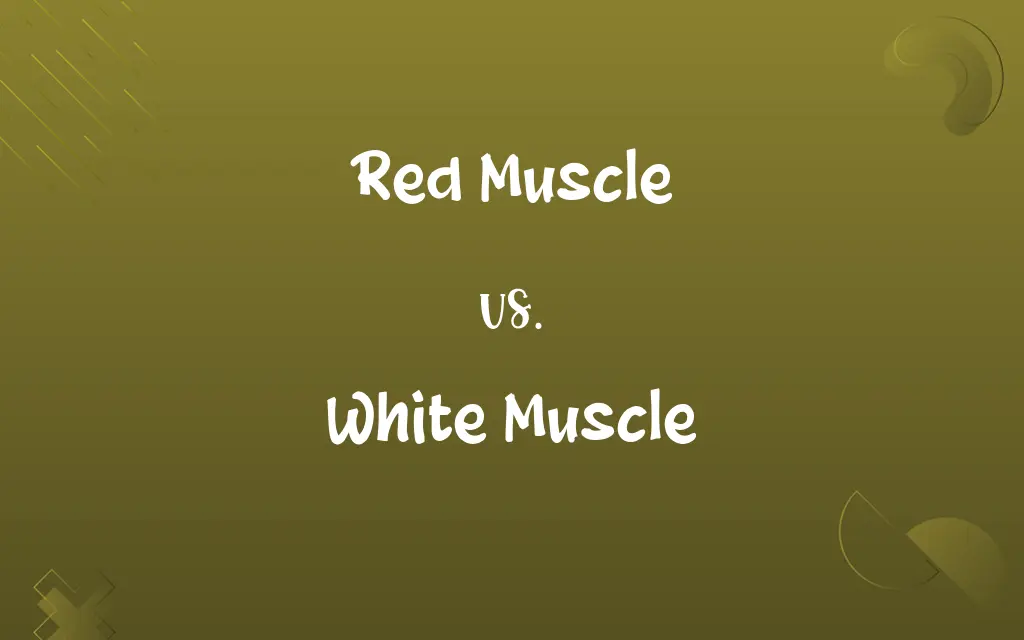Red Muscle vs. White Muscle: Know the Difference

By Shumaila Saeed || Updated on December 25, 2023
Red muscle is rich in myoglobin and mitochondria, supporting endurance, while white muscle has less myoglobin and is suited for short bursts of power.

Key Differences
Red muscle fibers are rich in myoglobin, giving them a reddish hue, and are adapted for sustained, aerobic activities. White muscle fibers, in contrast, contain less myoglobin, appearing paler, and are specialized for short, anaerobic bursts of power.
Shumaila Saeed
Dec 08, 2023
Red muscle is dense with mitochondria, the powerhouses of cells, facilitating continuous energy production for endurance tasks. White muscle, however, relies more on glycolytic enzymes, enabling quick energy release for rapid, intense actions but with less endurance.
Shumaila Saeed
Dec 08, 2023
Red muscle fibers have a higher blood supply, ensuring a steady flow of oxygen and nutrients, essential for prolonged activities. White muscle fibers have a comparatively lower blood supply, fitting their role in quick, high-intensity movements that last only briefly.
Shumaila Saeed
Dec 08, 2023
In terms of fatigue resistance, red muscle fibers are highly resistant due to their aerobic metabolism. White muscle fibers fatigue quickly as their anaerobic metabolism leads to the accumulation of lactic acid and rapid depletion of energy reserves.
Shumaila Saeed
Dec 08, 2023
Red muscle is typically found in muscles used for posture and endurance activities, such as in the legs of marathon runners. White muscle is more abundant in muscles that require quick, forceful contractions, like in the arms of sprinters.
Shumaila Saeed
Dec 08, 2023
ADVERTISEMENT
Comparison Chart
ADVERTISEMENT
Red Muscle and White Muscle Definitions
Red Muscle
Red muscle is adapted for continuous, steady activities.
Her red muscles were a testament to her regular yoga practice.
Shumaila Saeed
Dec 01, 2023
White Muscle
White muscle is muscle tissue with less myoglobin content.
His white muscles contributed to his explosive sprinting ability.
Shumaila Saeed
Dec 01, 2023
Red Muscle
Red muscle is muscle tissue rich in myoglobin and mitochondria.
The athlete's red muscles were well-developed, aiding in her long-distance running.
Shumaila Saeed
Dec 01, 2023
White Muscle
White muscle fatigues quickly.
After a quick sprint, his white muscles felt exhausted.
Shumaila Saeed
Dec 01, 2023
Red Muscle
Red muscle has a high oxygen supply.
The swimmer's red muscles efficiently used oxygen during her long training sessions.
Shumaila Saeed
Dec 01, 2023
ADVERTISEMENT
White Muscle
White muscle is suited for brief, high-intensity activities.
Her white muscles were crucial for her performance in the 100-meter dash.
Shumaila Saeed
Dec 01, 2023
Red Muscle
Red muscle fibers are slow-twitch, offering sustained power.
The red muscles in his calves supported hours of hiking.
Shumaila Saeed
Dec 01, 2023
White Muscle
White muscle primarily performs anaerobic respiration.
Weightlifters rely on white muscles for short, intense lifts.
Shumaila Saeed
Dec 01, 2023
Red Muscle
Red muscle primarily engages in aerobic respiration.
Marathon runners rely heavily on their red muscles for endurance.
Shumaila Saeed
Dec 01, 2023
White Muscle
White muscle fibers are fast-twitch, providing quick power.
The boxer's white muscles powered his rapid punches.
Shumaila Saeed
Dec 01, 2023
Repeatedly Asked Queries
What is red muscle?
Red muscle is a type of muscle tissue high in myoglobin and mitochondria, suited for endurance.
Shumaila Saeed
Dec 08, 2023
Why does white muscle appear paler?
It has less myoglobin, which gives muscle a darker color.
Shumaila Saeed
Dec 08, 2023
What activities rely on red muscle?
Endurance activities like marathon running or long-distance cycling primarily use red muscle.
Shumaila Saeed
Dec 08, 2023
Do red muscles have more mitochondria?
Yes, red muscles are rich in mitochondria, necessary for aerobic energy production.
Shumaila Saeed
Dec 08, 2023
Is red muscle more common in any specific body part?
It's commonly found in muscles used for posture and sustained activities.
Shumaila Saeed
Dec 08, 2023
Are red muscle fibers fast or slow-twitch?
They are slow-twitch fibers, designed for slow, sustained activities.
Shumaila Saeed
Dec 08, 2023
Why is red muscle red?
Its redness comes from myoglobin, a protein that binds oxygen, giving the muscle its color.
Shumaila Saeed
Dec 08, 2023
How does red muscle generate energy?
It uses aerobic metabolism, efficiently generating energy with a steady oxygen supply.
Shumaila Saeed
Dec 08, 2023
What sports benefit from white muscle?
Sports requiring quick, powerful movements like sprinting or weightlifting mainly use white muscle.
Shumaila Saeed
Dec 08, 2023
Are white muscle fibers resistant to fatigue?
No, they fatigue quickly due to their reliance on anaerobic processes.
Shumaila Saeed
Dec 08, 2023
How does diet affect red and white muscle?
Diet can influence muscle composition, with certain nutrients favoring the development of either type.
Shumaila Saeed
Dec 08, 2023
Can both muscle types be improved through exercise?
Yes, targeted exercise can enhance the efficiency and capacity of both red and white muscles.
Shumaila Saeed
Dec 08, 2023
How does white muscle produce energy?
It relies on anaerobic metabolism, quickly generating energy without oxygen.
Shumaila Saeed
Dec 08, 2023
Are there any diseases associated with red or white muscle?
Certain muscular diseases can preferentially affect either type, impacting their function.
Shumaila Saeed
Dec 08, 2023
How do genetics influence muscle type?
Genetics play a significant role in determining the proportion of red and white muscle fibers in an individual.
Shumaila Saeed
Dec 08, 2023
What is white muscle?
White muscle is muscle tissue with less myoglobin, specialized for short, intense bursts of activity.
Shumaila Saeed
Dec 08, 2023
What is the key difference in blood supply between red and white muscle?
Red muscle has a higher blood supply, aiding its endurance function, while white muscle has less.
Shumaila Saeed
Dec 08, 2023
Do animals have red and white muscles?
Yes, animals also have both red and white muscles, varying according to their lifestyle and activities.
Shumaila Saeed
Dec 08, 2023
Does age affect red and white muscle composition?
Yes, with age, there's often a decrease in muscle mass and a shift in fiber composition.
Shumaila Saeed
Dec 08, 2023
Can training alter muscle type?
Yes, consistent training can change the proportion of red and white muscle fibers to some extent.
Shumaila Saeed
Dec 08, 2023
Share this page
Link for your blog / website
HTML
Link to share via messenger
About Author
Written by
Shumaila SaeedShumaila Saeed, an expert content creator with 6 years of experience, specializes in distilling complex topics into easily digestible comparisons, shining a light on the nuances that both inform and educate readers with clarity and accuracy.







































































